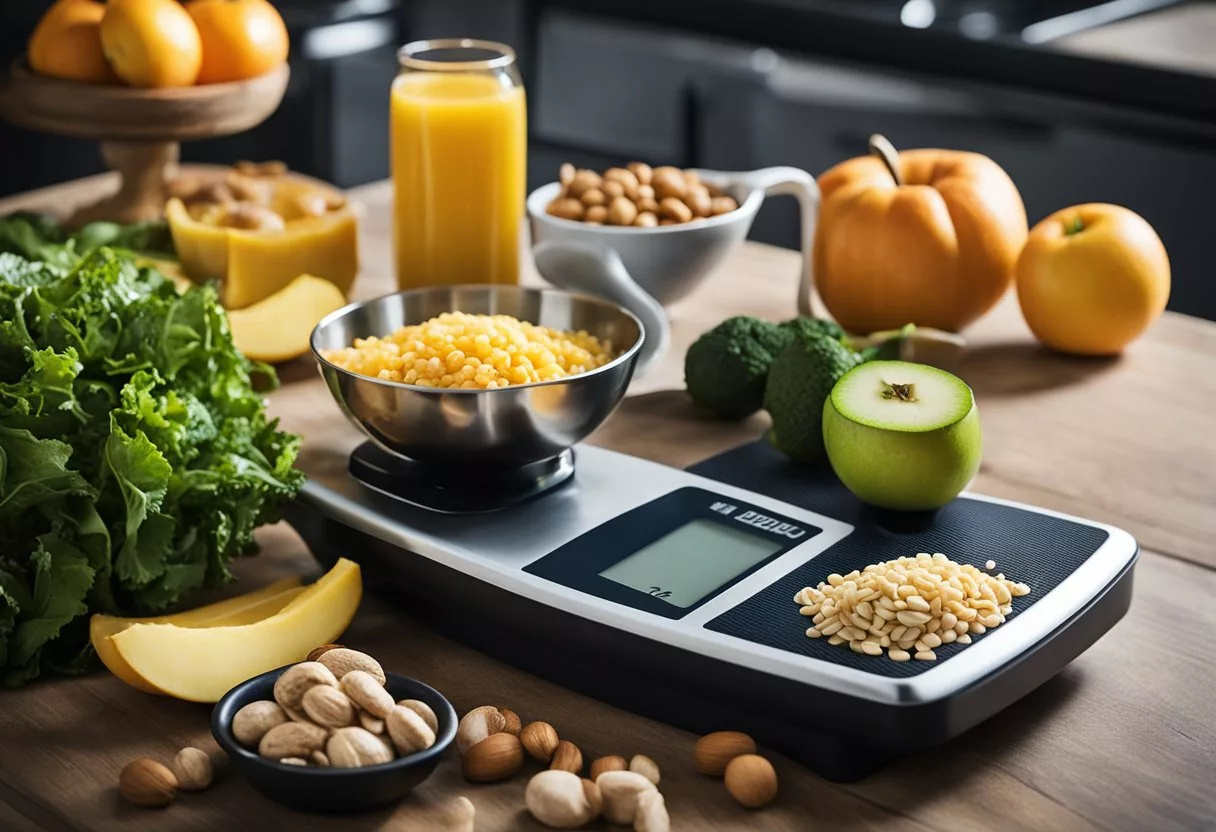A calorie deficit occurs when a person burns more calories than they consume. Creating a calorie deficit is essential for weight loss because it forces the body to use stored fat for energy. Many people find this approach straightforward yet effective for losing weight in a controlled and sustainable way.

To achieve a calorie deficit, you need to calculate your Total Daily Energy Expenditure (TDEE). This can be done using online tools like this calorie deficit calculator[1]. Once you know your TDEE, you can plan to consume fewer calories than you burn, often by reducing your intake by 500-1,000 calories per day.
Combining a balanced diet with regular physical activity can make maintaining a calorie deficit easier and more effective. Resources like Healthline’s guide[2] provide valuable tips on how to adjust your eating habits and exercise routines to support your weight loss goals.
Key Takeaways
- Creating a calorie deficit is key for weight loss.
- Calculating your TDEE helps manage a calorie deficit.
- Balanced diet and exercise aid in maintaining a calorie deficit.
Understanding Calorie Deficit

Calorie deficit is a core concept in weight loss, involving the balance between calorie intake and energy expenditure. It is crucial to understand how to calculate and maintain this balance to achieve and sustain weight loss.
Definition of Calorie Deficit
A calorie deficit occurs when you consume fewer calories than your body expends. This difference forces the body to use stored energy, leading to weight loss. The concept is based on the principles of energy balance and metabolism.
Your Total Daily Energy Expenditure (TDEE) includes all the calories you burn in a day, from basic bodily functions to physical activities. When your calorie intake is less than your TDEE, you experience a calorie deficit which helps in weight loss.
Calculating Calorie Needs
To create a calorie deficit, you must first know your daily calorie needs. This involves calculating your Basal Metabolic Rate (BMR) and adding your Resting Energy Expenditure (REE).
- Basal Metabolic Rate (BMR): The number of calories your body needs at rest.
- Total Daily Energy Expenditure (TDEE): BMR plus calories burned through physical activity.
Using a calorie calculator can help you determine these values. For example, if your TDEE is 2,000 calories and you aim for a 500-calorie deficit, your new daily goal is 1,500 calories.
Importance of Energy Balance
Energy balance is the relationship between calorie intake and energy expenditure. Achieving weight loss requires careful management of this balance.
- Calorie Deficit: Leads to weight loss by reducing calorie intake or increasing energy expenditure.
- Maintenance Calories: The number of calories needed to maintain your current weight.
- Calorie Surplus: Occurs when calorie intake exceeds energy expenditure, leading to weight gain.
Understanding these elements helps in making informed decisions about diet and exercise. Regular adjustments might be necessary as your weight changes, so keep monitoring your progress.
Effective weight loss is not about severe calorie restriction but about sustainable changes to maintain a healthy balance.
Nutritional Considerations in a Calorie Deficit

When managing a calorie deficit, it’s essential to balance macronutrients, choose nutrient-rich foods, and follow dietary guidelines to ensure overall health and effective weight loss.
Macronutrient Ratios
Balancing macronutrients—protein, carbohydrates, and fats—is crucial. Protein is especially important as it aids muscle preservation and promotes satiety. Sources like seafood, lean meats, nuts, and legumes are excellent choices. Carbohydrates should come primarily from whole grains, fruits, and vegetables for their vitamins, minerals, and fiber. Healthy fats, found in nuts, seeds, and fish, support brain health and hormone production.
Example Macronutrient Ratios:
- Protein: 25-30% of daily caloric intake
- Carbohydrates: 45-55%
- Fats: 20-30%
Choosing Nutrient-Rich Foods
Opt for foods that deliver the most nutrition per calorie. Vegetables, fruits, lean proteins, and whole grains are all nutrient-dense choices. These foods provide essential vitamins, minerals, and fiber while keeping caloric intake in check. Avoid processed foods high in sugar and unhealthy fats, as they often lack nutritional value and can hinder weight loss efforts.
Some good choices include:
- Vegetables: Broccoli, spinach, carrots
- Fruits: Berries, apples, bananas
- Proteins: Chicken breast, tofu, salmon
- Whole Grains: Brown rice, quinoa, oats
Understanding Dietary Guidelines
Following recognized dietary guidelines ensures a balanced and comprehensive diet. The Dietary Guidelines for Americans[3] suggest aiming for half of your plate to be fruits and vegetables, with a focus on variety and color. Whole grains and lean proteins should make up the remaining portions. Hydration is also critical; water is the best choice, while sugary drinks should be limited. Consulting a registered dietitian or nutritionist can provide personalized advice for maintaining a healthy weight while in a calorie deficit.
The Role of Physical Activity
Physical activity plays a crucial role in creating a calorie deficit, which is essential for losing weight. By increasing calorie expenditure through exercise, one can boost their efforts to reduce overall body weight and maintain muscle mass.
Exercise and Calorie Expenditure
Exercise significantly impacts calorie expenditure. Activities like running, cycling, and swimming increase one’s aerobic capacity and help burn calories. For example, engaging in physical activity[4] such as supervised exercise five days a week, burning 400-600 calories a session, can lead to substantial weight loss. Regular exercise also helps in maintaining muscle mass while losing fat, ensuring a healthy weight loss process.
Physical Activity Level and Weight Loss
Maintaining a high physical activity level is crucial for weight loss. According to the CDC, combining physical activity with a reduced-calorie diet creates a calorie deficit necessary for weight loss. Studies show that physical activity increases the number of calories the body uses for energy[5]. Incorporating just 30 minutes of regular exercise can enhance weight loss efforts and improve overall health.
Incorporating Movement Into Daily Routine
Incorporating movement into daily routines can help boost overall physical activity levels. Simple actions such as walking instead of driving, using stairs instead of elevators, and incorporating short exercise breaks during the day can add up. The aim is to spread physical activity throughout the day to continuously burn calories. These small changes help prevent fatigue and maintain consistent energy expenditure, increasing the likelihood of sustained weight loss[6].
Health Considerations and Risks

Maintaining a calorie deficit can help with weight loss, but it also poses several health risks. Severe calorie restriction, adverse effects on metabolism, and the need for professional monitoring are crucial points to be aware of.
Potential Risks of Severe Calorie Restriction
Severely restricting calorie intake can lead to significant health problems. A drastic calorie cut can cause muscle mass loss and nutrient deficiencies. When the body doesn’t get enough nutrients, health issues such as anemia, osteoporosis, and weakened immunity can arise.
Signs of nutrient deficiencies may include fatigue, dizziness, and nausea. An extreme calorie deficit may also lead to gallstones and high blood pressure. Furthermore, it can disrupt hormonal balance, reducing estrogen levels, which impacts bone and heart health.
Severe calorie restriction can be particularly harmful to individuals with pre-existing conditions like Type 2 diabetes or those at risk for obesity-related diseases.
Monitoring Health with Healthcare Providers
Regular check-ins with a healthcare provider are important when managing a calorie deficit. They can help ensure that the dietary changes do not negatively impact blood pressure, cholesterol levels, or overall body composition.
Healthcare providers can conduct blood tests to monitor nutrient levels and other vital signs. They can also recommend personalized dietary adjustments and monitor any signs of nutrient deficiencies or other health risks.
Regular consultation is especially essential for those with health conditions such as Type 2 diabetes or high blood pressure, as they need to carefully balance their diet to avoid complications.
Adverse Effects on Metabolism and Body Composition
A prolonged calorie deficit can slow down metabolism. When the body receives fewer calories than it needs, it may start conserving energy, leading to a slower metabolic rate. This adjustment can make achieving further weight loss more difficult over time.
Additionally, a severe calorie deficit often results in muscle loss. As the body breaks down muscle for energy, the overall body composition changes, increasing the proportion of body fat versus muscle mass. This change can have long-term impacts on strength and physical function.
Individuals experiencing a sedentary lifestyle might face additional risks, as physical activity is key to maintaining muscle mass and supporting a healthy metabolism. Regular exercise combined with moderate calorie restriction can help mitigate these adverse effects.
Weight Management and Lifestyle

Weight management involves more than just controlling calories. Factors like stress, sleep, hormones, and genetics also play significant roles. Implementing sustainable strategies can enhance quality of life without compromising health.
Sustainable Weight Loss Strategies
Adopting sustainable weight loss strategies is essential for long-term success. A combination of dietary modifications and lifestyle changes works best. Following dietary guidelines[7] that emphasize whole foods, lean proteins, and plenty of vegetables can help reduce calorie intake while maintaining nutrition.
Regular physical activity is equally important. Combining cardio and strength training helps burn calories and build muscle, which boosts the basal metabolic rate (BMR). Practicing intuitive eating can also aid in recognizing hunger cues and preventing overeating. This means eating when hungry and stopping when full, rather than following restrictive diets that may lead to constipation or other digestive issues.
Impact of Stress and Sleep on Weight
Stress and sleep are critical factors in weight management. High-stress levels can lead to emotional eating, where individuals reach for comfort foods high in calories. Stress also increases levels of cortisol, which can lead to an increase in body weight over time.
On the other hand, adequate sleep is crucial for maintaining a healthy weight. Poor sleep affects the balance of hunger hormones, increasing ghrelin (which stimulates appetite) and decreasing leptin (which signals fullness). Ensuring 7-9 hours of quality sleep per night helps regulate these hormones. Establishing a consistent bedtime routine and creating a restful sleep environment can make a significant difference.
Role of Hormones and Genetics
Hormones and genetics also influence an individual’s ability to lose weight and keep it off. Genetic factors can determine how the body processes food and stores fat. Some people may have a naturally higher BMR, while others might need to work harder to achieve the same results.
Hormones such as insulin, leptin, and ghrelin play roles in hunger and fat storage. Insulin resistance, for example, can make it harder to shed pounds as it affects how the body uses glucose. Understanding one’s hormonal balance and genetic predispositions can help tailor a personalized approach to weight management.
Implementing strategies that consider these factors can lead to more effective and sustainable weight management. Balancing diet, exercise, stress management, and sleep hygiene is key to achieving and maintaining a healthy weight.
Advanced Tools and Concepts
Advanced tools can significantly help in managing a calorie deficit for weight loss. These tools include calorie calculators and apps, the Harris-Benedict Formula, and strategies for adjusting your diet to accommodate rapid changes in your lifestyle or metabolism.
Using Calorie Calculators and Apps
Calorie calculators and apps are essential for anyone aiming to maintain a calorie deficit. These tools help track daily caloric intake and expenditure. They often include features for logging food intake, setting weight loss goals, and monitoring nutrient intake, such as protein, fats, and sugars.
Many popular apps integrate with wearables to offer real-time data on activity levels and resting metabolic rate. Examples of these apps include MyFitnessPal and Lose It!. Using these tools helps keep the portion sizes in check, monitors added sugars, and ensures protein intake is adequate for muscle maintenance.
Some advanced calculators, like the Body Weight Planner[1], can even predict changes in weight over time based on current data and goals.
Understanding the Harris-Benedict Formula
The Harris-Benedict Formula is a widely used method to estimate basal metabolic rate (BMR) and total daily energy expenditure (TDEE). This formula considers factors such as age, gender, weight, and height to calculate the energy needed at rest.
To utilize this formula effectively, you can find online calculators[8] that simplify the process. Accurate BMR calculation helps design a proper energy deficit plan, ensuring the calorie deficit is safe and sustainable.
By knowing your BMR, you can adjust your caloric intake and physical activity levels to achieve your weight loss goals without compromising your health. For instance, if your BMR is 1,500 calories, consuming 1,200 calories and burning an additional 300 through exercise could help achieve desired results.
Adjusting Diet for Rapid Changes
Sometimes, rapid adjustments in diet are necessary due to changes in lifestyle, health conditions, or weight plateaus. Strategies include reducing trans fats and added sugars, increasing fiber and protein intake, and monitoring blood sugar levels.
When experiencing water weight fluctuations, reducing sodium intake and increasing water consumption can help. Adjustments should also consider medications that might affect metabolism or appetite.
For more tailored advice, consulting a nutritionist or using specialized tools like the Calorie Deficit Calculator can offer personalized suggestions. Focusing on nutrient-rich foods and maintaining a balanced diet ensures that rapid changes do not negatively impact overall health.
Frequently Asked Questions

Creating a calorie deficit involves understanding how many calories you need daily and adjusting your intake and activities to ensure you consume fewer than you expend. Safe and sustainable weight loss depends on maintaining a manageable deficit and choosing nutrient-dense foods.
How do I calculate my calorie deficit for weight loss?
To calculate your calorie deficit, determine your Basal Metabolic Rate (BMR) and multiply it by your activity level. Subtract 300-500 calories from this total for a sustainable weight loss.
What is considered a safe calorie deficit for sustainable fat loss?
A safe calorie deficit typically ranges from 300-500 calories per day. This generally results in losing about 0.5 kilograms (1.1 pounds) per week, which is considered sustainable and healthy. Adjustments should be made as weight loss progresses to avoid plateauing.
At what rate should I aim to lose weight to ensure a healthy calorie deficit?
Aiming to lose about 0.5 to 1 kilogram (1.1 to 2.2 pounds) per week is a healthy goal. This rate helps preserve lean muscle mass and reduces the risk of nutritional deficiencies. Rapid weight loss is often unsustainable and can pose health risks.
What are the best foods to include in my diet to achieve a calorie deficit?
Focus on nutrient-dense, low-calorie foods such as vegetables, lean proteins, whole grains, and fruits. These foods provide essential nutrients while helping you stay within your calorie limits. Reducing high-calorie, low-nutrient foods like sugary snacks and fried foods can also help.
How does a calorie deficit differ between men and women?
Men typically have higher BMRs due to greater muscle mass, requiring more calories daily. Women generally need fewer calories, so their calorie deficits might be slightly smaller to achieve the same rate of weight loss. Hormonal differences can also influence how calories are utilized.
What methods can be used to track and maintain an effective calorie deficit?
Use tools like food diaries, calorie-tracking apps, or wearable fitness trackers to monitor your intake and expenditure. Regularly updating your activity level and re-evaluating your BMR ensures that your calorie calculations remain accurate. This consistency helps maintain an effective calorie deficit.
References
- Calorie Deficit Calculator. https://www.omnicalculator.com/health/calorie-deficit Accessed November 9, 2025
- What Is a Calorie Deficit, and How Much of One Is Healthy?. https://www.healthline.com/nutrition/calorie-deficit Accessed November 9, 2025
- Dietary Guidelines for Americans. https://www.health.gov/our-work/nutrition-physical-activity/dietary-guidelines Accessed November 9, 2025
- Role of Physical Activity for Weight Loss and Weight Maintenance. https://www.ncbi.nlm.nih.gov/pmc/articles/PMC5556592/ Accessed November 9, 2025
- Physical Activity and Your Weight and Health | Healthy Weight and Growth. https://www.cdc.gov/healthy-weight-growth/physical-activity/index.html Accessed November 9, 2025
- Impact of calorie restriction on energy metabolism in humans. https://www.ncbi.nlm.nih.gov/pmc/articles/PMC9036397/ Accessed November 9, 2025
- Optimal Diet Strategies for Weight Loss and Weight Loss Maintenance. https://www.ncbi.nlm.nih.gov/pmc/articles/PMC8017325/ Accessed November 9, 2025
- How to Achieve a Calorie Deficit for Weight Loss, Safely. https://barbend.com/calorie-deficit/ Accessed November 9, 2025
